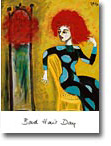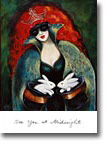the well-lived life of katharina rapp
from issue 9



Katharina Rapp is one woman who certainly seems to have it all. She has lived in many countries, has been a wife and mother, has run her own businesses and is now a successful painter. Katharina discusses her life journeys with Michelle Lovi and shows that a life well lived can be translated into work well painted.
Chapel Street in Melbourne is famous for its shopping scene. More clothes, shoes and accessories than you can max out your credit card on. But did you know about the fantastic artworks you can find there? I was drawn into a store selling framed oil paintings, prints and photos, when something playfully colourful caught my eye – I had to get a closer look.
Amongst the landscapes and abstract works were an array of gorgeous brightly coloured portraits of women in an assortment of poses and surroundings. The works of Katharina Rapp had me enthralled with her beautiful portrayals of women in love, in life, and having a ball… I had to learn more about this talented woman and the inspiration behind her art.
Katharina Rapp is widely travelled and has lived in many countries. She travels abroad at least once a year, mostly to Europe, but of late she has added New York and California to her itinerary. Katharina has made Australia her home, though, and while a part of her will always yearn for Europe, she is settled here. ‘At my age it would be downright careless to shift to another part of the world again. Moving many times before has taught me to appreciate the value of stable friendships and contacts. I can still make friends easily, but nothing can replace the investment of many years in one locality. My network, and therefore the focus of my work, is now right here.
Her worldly experiences have brought some unique perspectives to her work. ‘Travelling opens one’s mind. As you experience different cultures you can still get glimpses of things which are universal, and they are the core values in life. Everything else is fashion, or custom, or tradition.
‘In Scotland, for instance, I used to adore the full-scale, lifesize portraits of earls and dukes in full regalia, which hung in castles and old family homes. They were impressive portraits, conceived with the aim in mind of making their sitter look important, romantic, powerful, strong, and often the painter must have taken poetic licence to achieve those objectives. I lapped up the colourful costumes and the theatrical body language of it all.’
Katharina studied Decorative Arts in Stuttgart, Germany, followed by further studies at the Sorbonne in Paris, where she did a course in French Civilisation and Language. Soon after completing her degree, Katharina married a man who was in charge of a large symphony orchestra in London, and acquired first-hand insight into the world of classical music. In Australia she studied a BA in Fine Art at La Trobe University. She speaks four languages, ‘three fluently, the fourth so-so. Learning languages goes beyond words. You learn about life and the world in general, and about different points of view.’
Katharina’s travels, her education and her life all have influenced her work. ‘I might feel inspired by the different slant of looking at things, but often with a result quite different from what I’d seen. I would never copy what I’ve seen – because my paintings come from deep within. I do it the hard way. I have to journey to the centre of my soul to find new inspiration, and when that happens, it can happen anywhere, even in the bathroom.’
Katharina’s background in painting goes back a long way. Her father, who died two months before her birth, was also a painter. ‘There was always an underlying desire to continue where he’d left off. It was going to be a long time in coming.’ She married very young to a high achiever, and with three children, many moves across cities and countries, large houses, formal entertaining and generally being the supportive force behind the scenes she was kept extremely busy. ‘Once the heat was off and the children were at school, I started a highly innovative and creative knitwear business in Edinburgh, and then was egged on by a friend, who knew Anita Roddick, to open the first Body Shop outside of England. So I wound up running the two businesses side by side.
‘But at the back of my mind I knew that once the family thing would be behind me and I could afford to be more selfish, then I would paint. In order to paint well you have to have time to dream – without domestic pressures.’ Time is more important to Katharina than finding one place to call home. ‘When I have a good run behind the easel, then I become conscious of being at home within myself. It is within the feeling of being comfortable, at ease, while driven to do something meaningful, when I feel at home. The geographical situation is less important than the mental one.’
After 30 years of marriage and financial security, Katharina found herself divorced at the age of 50, and with no income. ‘If I had been something sensible like an accountant or a solicitor, or the editor of a magazine, then I might have had a chance of making a good living. But as a painter, in Australia???’
Katharina decided to set up her own studio. ‘I was determined to make a success of the rest of my life. After all, what did I have to lose? I knew that at my age I could not afford to wait for 20 years to make my mark. So I presented myself as if I were a success: I acted confidently, I dressed with care at all times, I was always punctual, always reliable – in other words, I presented myself in a professional manner. I knew that what I had to offer was unusual, and that my “product” was unique on the market. I spent twice the time of painting behind my desk, promoting and scheming, researching and writing letters and booklets and speeches, etc.
‘I did all this from an ordinary suburban house in a small country town, far away from the dazzling lights of the international art market. I felt very isolated at times, but I was equally determined to do it my way, and not to rely too much on galleries. I wanted to keep control of anything to do with my work, which was, after all, my life.’
Despite the financial considerations one must deal with when making art a career, Katharina maintains a strong focus on quality. ‘I would like to strengthen my technique, the way in which I express myself. I dream of letting rip the drama and passions that unfold within myself, to vent my turbulent emotions in the raw, rather than resort to witticisms. There are times when I ache to put on canvas the emotions I feel when I listen to certain music. Will I ever get there?
‘Then again, I am just a sucker for characterisation. Maybe I should have become an actress. I do have such a weakness for the offbeat persona.’ It is precisely this theatrical quality that entices and amuses viewers of Katharina’s work, which also expresses a mood or emotion through the human form.
Katharina’s work predominantly features women and ‘the better moments of a woman’s life’. This strong focus on ‘the better times’ comes from experience of the years after World War II, ‘when the landscape was dominated by widows clad in black mourning and crying their eyes out – you, too, would feel that you have had enough of the dark side of life.’
Katharina is by temperament of a cheery disposition. ‘During my sad childhood I formed a sort of self-preservation defence mechanism by escaping into daydreaming. I would stand in the snow with frozen fingers, but in my mind’s eye I was somewhere warm, light and full of love and laughter. It is this sort of wish fulfilling through fantasy that is still with me in my painting. If my private life is not as colourful as I would like it to be, then I paint what I can’t have. But then, perhaps I should add that my private life really has turned into a fairytale with a happy ending.’
Upon viewing her colourful portfolio, you’ll observe there are noticeably very few men in her paintings. On the surface, it would appear that Katharina has little interest in portraying the male experience. ‘On the contrary, I am very fond of men. However, women happen to be the more painterly creatures. They are more decorative, more like flowers. You can put ribbons or whatever into a painting with a female, just to add a touch of colour. This would be difficult with a man indeed! Also, it is easier for me to understand the psyche of my own sex, and therefore whatever I have to say seems to have more integrity.
‘This is not to say that there will never be any men in my paintings. As it happens, I have just had a funny idea…’
Katharina has some exciting plans for the future. ‘As I am bursting at the seams in my present domestic arrangements, I have been offered to move my operation into Degraves Mill, a historic bluestone building near Carlsruhe, south of Kyneton, on the Calder Highway. I shall have my studio and private showroom there later in the year. It will be the most amazingly beautiful space to work in, and I can sense already that what will come forth from there will be made of stronger stuff.’
You can view more of Katharina’s spectacular artwork on her website at www.katharinarapp.com.

